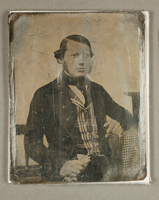Daguerreotypie: FotoGLV2000/9966 1845-1855
Samenvatting
Laden beelden
Object
Laden beelden
Behuizing
Laden beelden
Plaat
Laden beelden
Zilvermerk
Geen informatie beschikbaar over zilvermerk bij dit record
Galerij
Beeldrechten:
Europeana Rights Reserved – Free Access


Opmerkingen
Opmerkingen
Albin Mutterer was well-known in Vienna for his portrait photographs of the wealthy society as well as his portraits of deceased persons. Mutterer took portraits of the dead not only if they would appear to be asleep, but apparently if they would be alive with the eyes wide open and propped before the camera. The Albertina also owns a salt-print photograph of the editor Reitmayer which was made in 1864 and which is considered today as one of the most astonishing portraits of a deceased. However, there are conspiciously similarities between the salt print and this daguerreotype. My research on Mutterer's techniques show that the portrait of 1864 is actually a copy of the daguerreotype. I wrote a paper on this topic which I would like to share with Daguerreobase. My research paper can be downloaded here: https://www.essex.ac.uk/arthistory/research/pdfs/rebus-issue-7/munforte.pdf
Albin Mutterer was well-known in Vienna for his portrait photographs of the wealthy society as well as his portraits of deceased persons. Mutterer took portraits of the dead not only if they would appear to be asleep, but apparently if they would be alive with the eyes wide open and propped before the camera. The Albertina also owns a salt-print photograph of the editor Reitmayer which was made in 1864 and which is considered today as one of the most astonishing portraits of a deceased. However, there are conspiciously similarities between the salt print and this daguerreotype. My research on Mutterer's techniques show that the portrait of 1864 is actually a copy of the daguerreotype. I wrote a paper on this topic which I would like to share with Daguerreobase. My research paper can be downloaded here: https://www.essex.ac.uk/arthistory/research/pdfs/rebus-issue-7/munforte.pdf